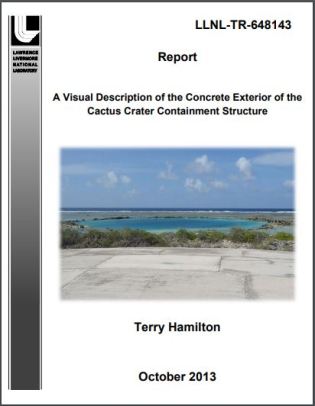Global Research, January 10, 2019
Nuclear Industries 9 January 2019
The Enewetak Atoll, in the Marshall Islands, is about halfway between Australia and Hawaii. After WWII, the atoll came under control of the US, and in 1948 the first nuclear test was carried out. For 10 years, as part of the Cold War, 43 nuclear bombs were detonated on Enewetak – twice as many tests as its neighbour, Bikini Atoll.
The US sent around 4000 personnel to the area in 1977 to clean the site. During the three-year process, they mixed contaminated soil and debris with cement and buried it in one of the blast craters on the beach. The concrete dome was added and in 1980 the atoll was said to be safe for habitation. Local residents returned the same year. But the effect of rising sea levels due to climate change had not been anticipated.

In 2013, Lawrence Livermore Laboratories issued a disturbing report commissioned by the US Department of Energywhich examined the ‘Cactus’ dome on Runit Island, one of 40 islands of the Enewetak Atoll, recorded the cracks and ordered repairs.
Double standards?
It noted (p2) that “If the Cactus crater concrete containment structure on Runit Island were located in the United States proper (or subjected to U.S. regulatory authority), it would be formally classified as a Low-Level Radioactive Waste Disposal Site and be subject to stringent site management and monitoring practices”.
A reader sent a link to an article by Australian journalist Phoebe Loomes, who reports that rising sea levels have added to the degradation of the large, concrete-dome holding the toxic materials which are leaking into the Pacific Ocean.
Mike Willacy, an investigative journalist, travelled to the Marshall Islands for the ABC’s Foreign Correspondent program in 2017. He said that the dome was only meant to be a temporary solution until the US came up with a permanent plan – a cost-cutting exercise.
He saw the cracks in the concrete dome and was told that residents feared for their lives if the structure collapsed. They warned of the fallout that could arise from the water flowing into the Pacific Ocean.

“Seawater is penetrating the underside of the dome, because when they threw all this material into the old bomb crater, they didn’t line it with anything. They were supposed to line it with concrete, but that never happened because of cost considerations. So, as the sea level has risen, the groundwater level has risen and therefore you have groundwater penetrating inside the dome, because a lot of this atoll is obviously sand (and) coral. It’s permeable material.”
In the Marshall Islands, the most common cause of death is diabetes, which is related to a thyroid disorder – the second is cancer. There are high levels of birth defects, cancer and thyroid problems, which locals attribute to continued fallout from the radioactive bombing of the area.
The population of the Marshall Islands is around 70,000 and local people are allowed to live and work in the US without a visa as part of the reparations for the nuclear testing that took place. Over a third have already moved to the US. Ms Loomes adds, “It is said that when you leave the Marshall Islands, you buy a one-way ticket”.
As sea levels continue to rise and the climate becomes more unstable, residents of the Marshall Islands are faced with the harsh reality that their island homes are becoming uninhabitable. Willacy writes:
“The children who live there refer to themselves as ‘the last generation’ “.
*
Note to readers: please click the share buttons above. Forward this article to your email lists. Crosspost on your blog site, internet forums. etc.
All images in this article are from Nuclear Industries
The original source of this article is Nuclear Industries
Copyright © Nuclear Industries, Nuclear Industries, 2019
https://www.globalresearch.ca/nuclear-weapons-tests-in-the-enewetak-atol-rising-sea-levels-add-to-the-toxic-legacy/5665155
JUST NEWS published this article following the Creative Commons rule. If you don't want your article to appear in this blog email me and I will remove it asap.

No comments:
Post a Comment